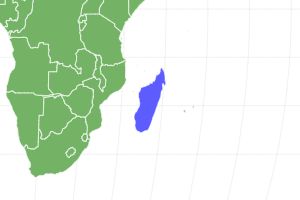Fossa
Cryptoprocta ferox
Most closely related to the Mongoose!
Advertisement
Fossa Scientific Classification
- Kingdom
- Animalia
- Phylum
- Chordata
- Class
- Mammalia
- Order
- Carnivora
- Family
- Eupleridae
- Genus
- Cryptoprocta
- Scientific Name
- Cryptoprocta ferox
Read our Complete Guide to Classification of Animals.
Fossa Conservation Status
Fossa Facts
- Prey
- Lemurs, Frogs, Lizards
- Name Of Young
- Cub
- Group Behavior
- Solitary
- Fun Fact
- Most closely related to the Mongoose!
- Estimated Population Size
- Less than 2,500
- Biggest Threat
- Habitat loss
- Most Distinctive Feature
- Webbed toes and retractable claws
- Gestation Period
- 3 months
- Habitat
- Dense tropical forest
- Predators
- Human, Crocodile
- Diet
- Carnivore
- Average Litter Size
- 2
- Lifestyle
- Nocturnal
- Common Name
- Fossa
- Number Of Species
- 1
- Location
- Madagascar
- Slogan
- Most closely related to the Mongoose!
- Group
- Mammal
Fossa Physical Characteristics
- Color
- Brown
- Red
- Black
- Skin Type
- Fur
- Top Speed
- 35 mph
- Lifespan
- 15 - 20 years
- Weight
- 7kg - 12kg (15lbs - 28.5lbs)
- Length
- 61cm - 80cm (24in - 32in))
- Age of Sexual Maturity
- 4 years
- Age of Weaning
- 4 months
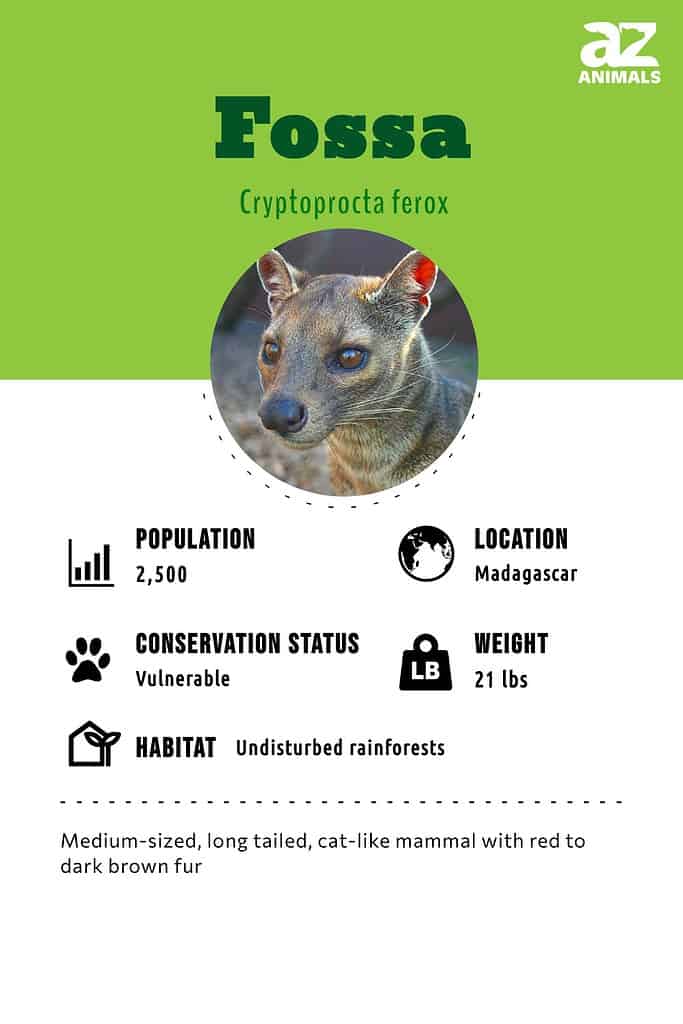
Classification And Evolution
The Fossa is a medium-sized, carnivorous animal that is located entirely on the island of Madagascar. The Fossa belongs to the group of Malagasy Carnivores, which are thought to have descended from ancestors that were Mongoose-like, that arrived in Madagascar from Africa almost 24 million years ago. Not only is it one of the most ancient of the eight species found on the island but it is also the largest. Due to its cat-like appearance, until recently, it was believed to be a primitive species of feline. Unfortunately, like various numbers of the unique animal species found in Madagascar, the Fossa is incredibly rare and due to the loss of natural habitat is now considered to be endangered.
Anatomy And Appearance
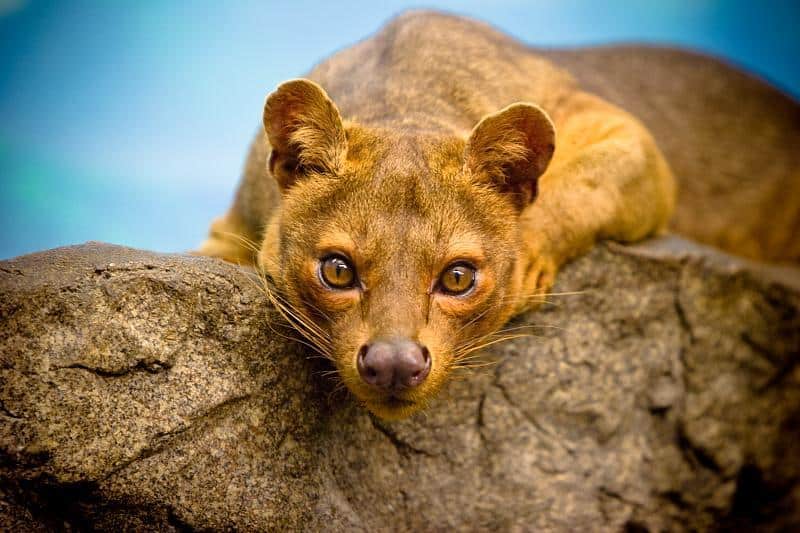
The fossa is called the King of Madagascar.
©kellinahandbasket / Flickr – License
The Fossa is the largest land predator on the island of Madagascar and some individuals of the species can grow to nearly 7 feet in length from their nose to the tip of their long and slim tails. The Fossa’s tail is around the same length as its body and plays a vital role in aiding them to balance as it leaps through the trees. The Fossa is an animal with short but dense red to dark brown fur, a small cat-like head, a dog-like snout, large forward-facing eyes, and small, rounded ears. In spite of being related to Mongooses, the Fossa has quite a number of feline features including curved, retractable claws and slightly webbed feet which both help when it is moving about amongst the branches.
Distribution And Habitat

Like the majority of plant and animal species found in Madagascar, the Fossa is an animal that is found nowhere else in the world. They rely on forested areas that are dense where there is an ample food source as well as plenty of space where they can establish a large territory. Historically, Fossas would normally have been found in the woodland and forested areas across the island from coastal lowlands to mountainous regions, but due to extensive deforestation throughout Madagascar they are now restricted to a tiny portion of their once vast natural range. Growing human populations have also severely affected Madagascar’s Fossa numbers as they are often hunted by farmers who fear for their livestock.
Behavior And Lifestyle
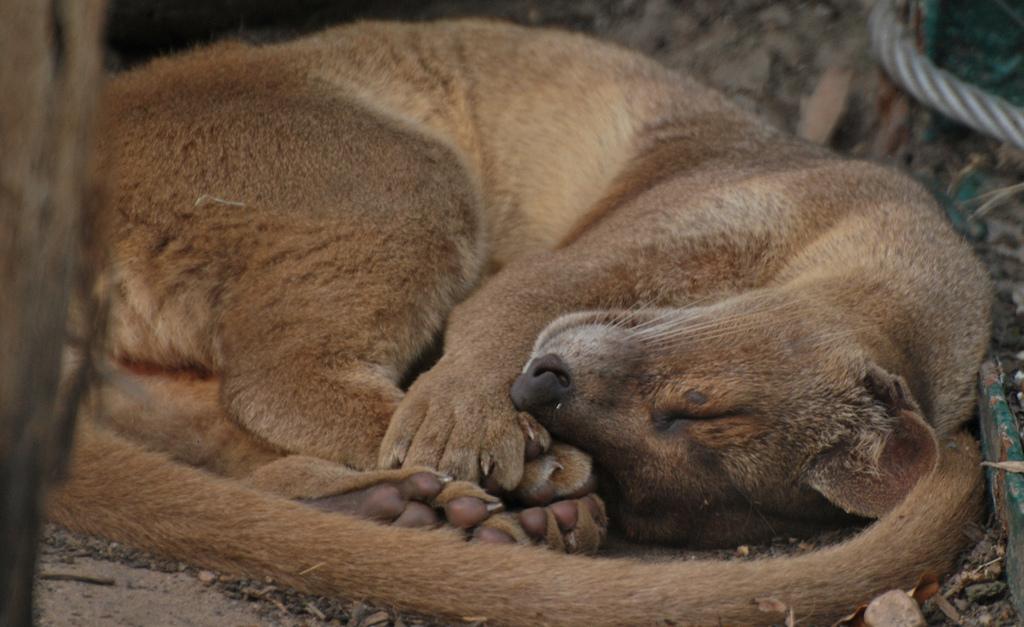
A Fossa will spend the day resting in a tree, cave or an abandoned termite mound.
©Josh Henderson / Flickr – License
The Fossa is a nocturnal mammal, preferring to be alone, that patrols territories as large as 1.55 square miles and marks its presence with scent released from its large anal gland. The vast majority of the fossa’s life is spent high in the trees but is known to move about and hunt on the ground as well. They are incredibly agile at both climbing and leaping, which is largely aided by their long and slender tail and the fact that they move about on the flat soles of their feet means that they have more balance and stability when landing precariously on branches. Although the Fossa is largely nocturnal, they are known to also hunt during the day, especially when they lack food, but prefer to spend the daylight hours resting in a hollow tree, cave, or an abandoned termite mound.
Reproduction And Life Cycles

Fossas, similar to other solitary carnivores, come together only to mate. Their breeding season is generally in September and October. With a gestation period that lasts around three months, the female will give birth to normally two cubs. The cubs are are very underdeveloped at birth and don’t open their eyes until they are between two and three weeks old. The young are cared for by their mother and begin to eat solid foods around 12 weeks old, although it takes another month until they are weaned. It takes almost two years for young fossas to grow to their adult size and another two years until they are able to reproduce. They can live for up to 17 years although many reach much younger ages.
Diet And Prey
The largest carnivorous mammal on Madagascar, the fossa survives by eating other animals in the surrounding area and has evolved to be the perfect hunter of Lemurs, a favorite staple of their diet. More than half of the Fossa’s nourishment is comprised of them. They will also eat lizards, birds, rodents, frogs, and reptiles to supplement their diet along with small domestic animals like pigs and poultry. By hunting at night, the dark coat of the Fossa is perfectly camouflaged into the thick surrounding forest so they are able to stalk their prey quietly in the trees before leaping powerfully to capture it. The retractable claws of the Fossa mean that they are always at their sharpest for catching prey as they are not being dulled by being constantly walked on.
Predators And Threats
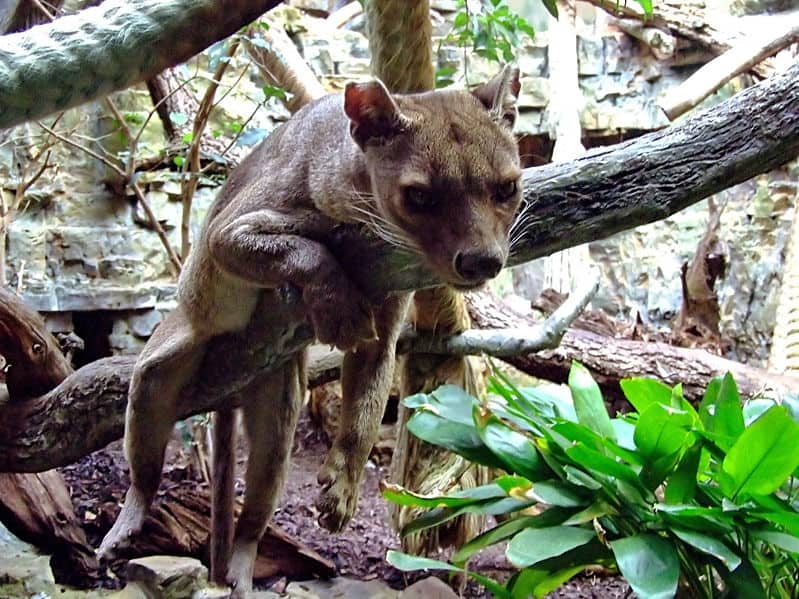
Fossa (Cryptoprocta ferox) is threatened due to deforestation.
Because the Fossa is the largest natural predator in Madagascar, it has no predators itself (with perhaps the rare exception of being grabbed by a stray Crocodile). Humans pose the biggest threat to the Fossa for they have not only hunted them in order to protect their livestock but they have also completely obliterated 90% of the Fossa’s once vast natural range. Deforestation due to logging for rare tropical timber and for clearing of land for agriculture has led to extensive declines in the wild population numbers. Coupled with the fact that Fossas require large solitary home ranges and are relatively slow at developing, it is thought that their numbers will most likely continue to drop.
Interesting Facts And Features
The Fossa usually measures around 3 feet long with the same length tail on top of that but, more recently, fossils of the now-extinct Giant Fossa have been uncovered in the jungles of Madagascar, with the biggest Giant Fossa fossil measuring nearly 20 feet in length and thought to have weighed around 37.5 lbs! As the Fossa is well known for its dominant and fierce approach to hunting, it is extremely rare that its intended prey will successfully escape. The Fossa is unbelievably fast and incredible agile in the tree tops so once a meal has been spotted, it is very accomplished at catching it.
Relationship With Humans
When early explorers first arrived on Madagascar, most of the incredible variety of unique fauna and flora, that they would have seen is most likely no longer in existence. Since their first arrival, humans have been exploiting one of the world’s largest islands leaving just 10% of the tropical forest cover. Land clearance for agriculture for uses for palm oil plantations and deforestation of the unique tropical trees has led to drastic declines in the population of a multitude of species, including the unique Fossa.
Conservation Status And Life Today
The Fossa is currently listed by the IUCN as being an Endangered species and at risk of becoming extinct in the near future in its natural environment. There are national parks and reserves that exist on the island, but they aren’t large enough to ensure that the Fossa population can survive as each individual requires a significantly large amount of territory and there is too much competition. It is estimated that there are less than 2,500 Fossas left in the wild of Madagascar.
View all 91 animals that start with FFossa FAQs (Frequently Asked Questions)
Are Fossas herbivores, carnivores, or omnivores?
Fossas are Carnivores, meaning they eat other animals.
What Kingdom do Fossas belong to?
Fossas belong to the Kingdom Animalia.
What class do Fossas belong to?
Fossas belong to the class Mammalia.
What phylum to Fossas belong to?
Fossas belong to the phylum Chordata.
What family do Fossas belong to?
Fossas belong to the family Eupleridae.
What order do Fossas belong to?
Fossas belong to the order Carnivora.
What type of covering do Fossas have?
Fossas are covered in Fur.
What genus do Fossas belong to?
Fossas belong to the genus Cryptoprocta.
Where do Fossas live?
Fossas live in Madagascar.
In what type of habitat do Fossas live?
Fossas live in dense tropical forests.
What are some predators of Fossas?
Predators of Fossas include humans and crocodiles.
How many babies do Fossas have?
The average number of babies a Fossa has is 2.
What is an interesting fact about Fossas?
Fossas are most closely related to the Mongoose!
What is the scientific name for the Fossa?
The scientific name for the Fossa is Cryptoprocta ferox.
What is the lifespan of a Fossa?
Fossas can live for 15 to 20 years.
How many species of Fossa are there?
There is 1 species of Fossa.
What is the biggest threat to the Fossa?
The biggest threat to the Fossa is habitat loss.
How many Fossas are left in the world?
There are less than 2,500 Fossas left in the world.
How fast is a Fossa?
A Fossa can travel at speeds of up to 35 miles per hour.
How to say Fossa in ...
Thank you for reading! Have some feedback for us? Contact the AZ Animals editorial team.
Sources
- David Burnie, Dorling Kindersley (2011) Animal, The Definitive Visual Guide To The World's Wildlife
- Tom Jackson, Lorenz Books (2007) The World Encyclopedia Of Animals
- David Burnie, Kingfisher (2011) The Kingfisher Animal Encyclopedia
- Richard Mackay, University of California Press (2009) The Atlas Of Endangered Species
- David Burnie, Dorling Kindersley (2008) Illustrated Encyclopedia Of Animals
- Dorling Kindersley (2006) Dorling Kindersley Encyclopedia Of Animals
- David W. Macdonald, Oxford University Press (2010) The Encyclopedia Of Mammals
- Fossa Facts, Available here: http://www.edgeofexistence.org/mammals/species_info.php?id=43
- Fossa Information, Available here: http://animaldiversity.ummz.umich.edu/site/accounts/information/Cryptoprocta_ferox.html
- Fossa Conservation, Available here: http://www.iucnredlist.org/apps/redlist/details/5760/0

